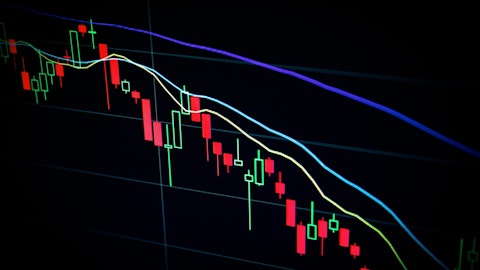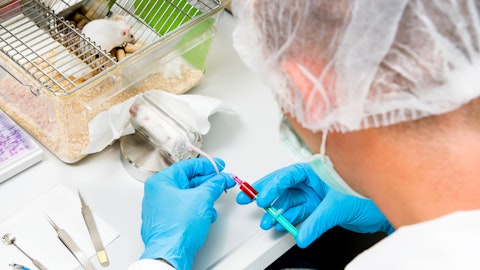AbbVie Inc. (NYSE:ABBV) Q3 2023 Earnings Call Transcript October 27, 2023
Operator: Good morning and thank you for standing by. Welcome to the AbbVie Third Quarter 2023 Earnings Conference Call. All participants will be in a listen-only mode until the question-and-answer portion of this call. [Operator Instructions] I would now like to introduce Ms. Liz Shea, Senior Vice President, Investor Relations. Thank you. You may begin.
Liz Shea: Good morning and thanks for joining us. Also on the call with me today are Rick Gonzalez, Chairman of the Board and Chief Executive Officer; Rob Michael, President and Chief Operating Officer; Jeff Stewart, Executive Vice President and Chief Commercial Officer; Scott Reents, Executive Vice President and Chief Financial Officer; Carrie Strom, Senior Vice President, AbbVie and President, Global Allergan aesthetics; and Tom Hudson, Senior Vice President, R&D and Chief Scientific Officer. Joining us for the Q&A portion of the call is Roopal Thakkar, Senior Vice President, Development and Regulatory Affairs and Chief Medical Officer. Before we get started, I’ll note that some statements we make today may be considered forward-looking statements based on our current expectations.

A doctor in a hospital conducting a clinical trial for a new biopharmaceutical drug.
AbbVie cautions that these forward-looking statements are subject to risks and uncertainties that may cause actual results to differ materially from those indicated in our forward-looking statements. Additional information about these risks and uncertainties is included in our SEC filings. AbbVie undertakes no obligation to update these forward-looking statements, except as required by law. On today’s conference call, non-GAAP financial measures will be used to help investors understand AbbVie’s business performance. These non-GAAP financial measures are reconciled with comparable GAAP financial measures in our earnings release and regulatory filings from today, which can be found on our website. Following our prepared remarks, we will take your questions.
So with that, I will turn the call over to Rick.
Rick Gonzalez: Thank you, Liz. Good morning, everyone, and thank you for joining us today. AbbVie continues to perform exceptionally well. We once again delivered an excellent quarter with results ahead of our expectations. We are now several quarters into the U.S. biosimilar event for Humira and continue to effectively manage erosion. We have been able to maintain significant volume with the majority of the impact to date driven by lower price. Importantly, our growth platform, the base business excluding Humira, which includes a well-diversified portfolio with multiple leading products in highly attractive markets across immunology, neuroscience, oncology, and aesthetics continues to demonstrate robust performance and outperform expectations.
This platform, which is the critical driver in our return to rapid growth in 2025 and beyond, delivered strong double digit revenue growth this quarter, a considerable acceleration from the first half of this year. We anticipate this platform, which is led by Skyrizi, Rinvoq, Vraylar, and Botox will continue to drive significant revenue growth going forward. At the same time, we have several promising R&D programs with the potential to contribute meaningfully in the latter part of this decade and into the 2030s. This includes next generation approaches in immunology, a focus on bispecifics, ADCs, and novel I-O in oncology, as well as innovative therapies to potentially treat a range of neuropsychiatric and neurodegenerative disorders. In summary, I’m extremely pleased with the continued strong momentum and execution across our business.
The growth platform is substantially outperforming our expectations, giving us the confidence to once again raise our financial outlook, including upgraded guidance for floor earnings, which Rob will share momentarily. And further underscoring our confidence in AbbVie’s long-term outlook, today, we also announced an increase in our quarterly dividend, which we have grown by more than 285% since our inception. With that, I’ll turn the call over to Rob for additional comments on our business performance. Rob?
Rob Michael: Thank you, Rick. Our results once again demonstrate the strength of our broad portfolio and support AbbVie’s long-term growth outlook. We reported adjusted earnings per share of $2.95, which is $0.14 above our guidance midpoint. Total net revenues were $13.9 billion, roughly $225 million ahead of our guidance. The performance of our ex-Humira growth platform continues to be very strong with revenue growth above 12% this quarter, including more than 50% growth from both Skyrizi and Rinvoq, our best in category immunology medicines. We continue to anticipate that these two products will collectively exceed Humira peak revenues by 2027 with robust growth expected into the next decade. Neuroscience also delivered strong performance with operational sales growth of more than 20% this quarter, driven by our leading portfolio for migraine and psychiatric conditions.
And lastly, aesthetics performance was highlighted by the return to growth of the U.S. toxin market. This outstanding execution across our well-diversified portfolio gives us the confidence to once again raise our near-term financial outlook. We are increasing our full year revenue guidance by $600 million and have now raised total revenue by $2 billion since our initial guidance in February, including more than $1.4 billion from our ex-Humira growth platform. As a result, we are also raising our full year adjusted earnings per share guidance by $0.25, and now expect adjusted EPS between $11.19 and $11.23. Given the strong momentum of our growth platform, which is significantly outperforming our expectations this year, we are now raising the floor guidance for 2024 adjusted EPS to $11, which is $0.30 better than our previous expectations.
This floor guidance continues to exclude any impact from IPR&D expense. As is our typical practice, we’ll provide our formal EPS guidance range for 2024 on the fourth quarter call. Finally, today, we are announcing a 4.7% increase in our quarterly cash dividend from $1.48 to $1.55, beginning with a dividend payable in February 2024. Since inception, we have grown our quarterly dividend by more than 285%. In summary, I’m very pleased with the strong execution across our portfolio. We remain confident in our long-term outlook, including a return to robust revenue growth in 2025 with a high single digit CAGR to the end of the decade. With that, I’ll turn the call over to Jeff for additional comments on our commercial highlights. Jeff?
Jeff Stewart: Thank you, Rob. We once again delivered strong results across our therapeutic portfolio this quarter. I’ll start with immunology, which delivered total revenues of nearly $6.8 billion exceeding our expectations. Skyrizi and Rinvoq continue to demonstrate impressive growth and are now on pace to deliver approximately $11.6 billion in combined sales this year. This performance is especially encouraging, recognizing that we are still in the early launch phase for both assets and IBD, an area of high unmet need where we are very competitively positioned with two complementary assets, each having generated strong response rates and durable remission across our development programs. Skyrizi total sales were $2.1 billion, reflecting operational growth of more than 50%.
This robust performance includes further share gains in psoriasis, where we remain the clear market leader, capturing roughly one-third of the total prescriptions in the U.S. biologic market, and approximately 50% of in-play patients who are either new to therapy or switching. Increasing momentum in psoriatic arthritis, where Skyrizi is now the leading in-play biologic therapy in the U.S. dermatology segment, as well as continued rapid uptake in Crohn’s disease where we are capturing roughly one out of every four in-play patients. Importantly, we recently announced positive results from SEQUENCE the ninth and perhaps the most impactful head-to-head study across our development program for Skyrizi and Rinvoq. SEQUENCE is a Phase 3 head-to-head study in Crohn’s, which demonstrated Skyrizi’s superiority versus Stelara across key efficacy parameters, including impressive, statistically significant differences in both clinical and endoscopic remission.
The detailed data from this trial were presented earlier this month, and we plan to share the findings more broadly now via our medical personnel and representatives in the field. We anticipate these strong head-to-head results will clearly support Skyrizi as the best in category therapy for Crohn’s, which is important for continued rapid share capture. So based on this very positive data as well as our continued momentum, we will be once again raising the full year sales outlook for Skyrizi. Moving now to Rinvoq, which delivered global sales of $1.1 billion, reflecting operational growth of nearly 60% with increasing prescriptions across each of the approved indications. In particular, I am very excited about Rinvoq’s growth potential in gastroenterology, where uptake is exceeding our expectations.
In ulcerative colitis, Rinvoq is now capturing more than 25% total in-play patient share in the U.S. second-line plus setting, nearly at parity to the current market-leading therapy. And in Crohn’s disease, Rinvoq is ramping very significantly. The inflection we are seeing is even faster when compared to our time aligned launch in UC just last year. Given this impressive momentum in IBD, we will now be raising our full year sales outlook for Rinvoq. Global Humira sales were more than $3.5 billion, down 36.2% due to biosimilar competition. The erosion impact in the U.S. played out largely in line with our expectations this quarter, while performance across our international markets is trending better-than-expected. Turning now to oncology, where total revenues were $1.5 billion.
Imbruvica global revenues were $908 million down 20% and consistent with our expectations. Venclexta global sales were $590 million, up 14% on an operational basis with strong demand for CLL and AML across our key countries. The U.S. launch of at EPKINLY in third line plus DLBCL is also tracking well with commercialization also now underway in Europe and Japan, following the recent respective approvals. In neuroscience, total revenues were more than $2 billion, up 22% on an operational basis. Vraylar continues to demonstrate robust growth. Global sales of $751 million were up 35.4% and we have seen a significant uplift in new prescriptions across all indications, following the approval as an adjunctive treatment for major depressive disorder late last year.
Our leading oral CGRP portfolio for migraine contributed $365 million in combined sales this quarter, reflecting growth of nearly 65%, as we continue to see strong demand for both Ubrelvy and Qulipta. Atogepant was also recently approved as a new therapy in Europe branded as Aquipta, where it is the only once-daily oral CGRP for prevention of both episodic and chronic migraine, further strengthening our competitive product profile and long-term growth opportunity. Lastly, total Botox Therapeutic global sales were $748 million, up 7.4% on an operational basis, reflecting momentum in chronic migraine as well as other approved indications. So overall, I am extremely pleased with commercial execution across the therapeutic portfolio, especially with our growth platform, which is demonstrating strong revenue growth.
And with that, I’ll turn the call over to Carrie for additional comments on aesthetics. Carrie?
Carrie Strom: Thank you, Jeff. Third quarter global aesthetics sales were approximately $1.2 billion, an operational decline of 4%. In the U.S., aesthetic sales of $759 million were roughly flat to last year as growth for Botox Cosmetic was offset by declines in other brands that continue to be impacted by lower consumer spending related to inflationary pressures. U.S. Botox Cosmetic sales were $388 million, an increase of 5%. We are beginning to see a recovery in the U.S. toxin market, which posted positive year-over-year growth in the third quarter following three consecutive quarters of declines due to economic pressures. Botox continues to perform very well despite increasing competition. It remains the clear market leader with a strong and stable share, and we have seen little to no share impact from new competitive entrants.
U.S. Juvederm sales were $116 million in the third quarter, a decline of 6.4% versus prior year as recovery in the facial filler market continues to lag the cosmetic toxin market. The filler market is improving, however, as a higher priced, more deferrable procedure relative to toxins. The segment of the aesthetics market continues to be suppressed by lower consumer spending. In the third quarter, the U.S. facial filler market was down low teens percentage compared to the prior year. Juvederm remains the market-leading facial seller in the U.S. and share was stable in the quarter. While the U.S. facial injectable markets continue to be impacted by lower consumer spending in this inflationary environment, we are seeing signs of stabilization and even a return to growth in the cosmetic toxin segment.
This gives us confidence in a stable to improving outlook in the U.S. as we end this year and enter 2024. Internationally, third quarter aesthetic sales were $480 million, representing an operational decline of 9.7%. As anticipated, year-over-year performance in the quarter was impacted by a shipment timing benefit we experienced in the third quarter of last year. Results were also impacted by softening economic conditions across major international aesthetic markets, primarily China. Despite the economic pressures that are currently impacting our aesthetics portfolio, we remain very confident in its long-term growth outlook. In September, we began launching Skin Vive in the U.S. And in the next few years, we plan to launch new indications for Botox in the lower face segment, and our novel fast-onset, short-duration toxin BoNT/E.
In addition to our R&D programs, we have a robust Alle technology pipeline, which will bring new tech products into the U.S. market to help our customers acquire, retain and cross-sell more aesthetic patients. Our strong leadership positions in both cosmetic toxins and facial fillers combined with the significant investments we’re making to drive market acceleration will position us for strong growth going forward. With that, I’ll turn the call over to Tom.
Tom Hudson: Thank you, Carrie. In immunology, we had two important milestones in the third quarter for Skyrizi in inflammatory bowel disease. Following completion of the Phase 3 maintenance trial in ulcerative colitis. We submitted our regulatory applications for Scares in this indication in the U.S. and Europe with approvals anticipated in 2024. We also recently presented results from the SEQUENCE head-to-head trial comparing Skyrizi to Stelara in patients with moderate to severe Crohn’s disease. We’re extremely pleased with how Skyrizi performed in this study, which enrolled very difficult-to-treat patients who all failed anti-TNF therapy. Skyrizi met the primary and all secondary endpoints in the trial, demonstrating clear superiority to Stelara on all endpoints at week 48 and with a more than doubling of effect in endoscopic remission at 32% of Skyrizi versus 16% for Stelara and endoscopic response at 45% versus 22% for Stelara.
Furthermore, steroid-free clinical remission was 61% for Scares versus 40% for Stelara. So these compelling head-to-head Crohn’s data combined with the additional indication approval for ulcerative colitis expected next year will further position Skyrizi as a highly effective, durable, safe and well-tolerated treatment option for patients with moderate to severe inflammatory bowel disease. We continue to make very good progress with the second wave of Rinvoq development programs as well in addition to the ongoing Phase 3 programs in GCA, lupus and HS, we recently began the Phase 3 program for Rinvoq in Alopecia Areata. We also recently announced positive top line results from a Phase 2 study for Rinvoq in vitiligo. In this study, Rinvoq met the primary and all secondary endpoints at week 24 and demonstrating a significant improvement in both facial and total body vitiligo scoring measures compared to placebo.
Importantly, these results continued to improve through week 52 of the study illustrating Rinvoq’s potential to provide significant skin repigmentation to patients suffering from vitiligo. Based on these results, we’re advancing Rinvoq to Phase 3 in this indication with studies expected to begin soon. Moving to oncology, where in the quarter, we received approval in Europe and Japan for epcoritamab as a monotherapy treatment for patients with relapsed or refractory DLBCL, were received two or more systemic therapies. These approvals represent important regulatory milestones for EPCO, and we look forward to bringing this new subcutaneous treatment option to patients in these international markets. We also continue to make good progress with the development programs in earlier lines of DLBCL and follicular lymphoma and we look forward to providing updates on these programs as the data mature.
In our Venclexta multiple myeloma program, we recently announced top line results of a Phase 3 CANOVA trial evaluating Venclexta plus dexamethasone compared to PomDex in relapsed/refractory patients with a T114 mutation. In this study, the primary endpoint of IR CSS PFS was longer with VenDex versus PomDex but did not meet statistical significance. accommodation also resulted in numerically higher response rates and longer overall survival compared to PomDex. While the differences in efficacy measures were not statistically significant, we believe the totality of the data show a benefit with the Venclexta combination and we plan to discuss the results with regulatory agencies. We’ll provide updates on the program as they become available. Behind Venclexta, we have several exciting multiple myeloma programs emerging from our earlier stage pipeline.
We continue to make good progress with our BCMA CD3 bispecific ABBV-383 and where we’re nearing completion of the dose optimization work and are on track to begin Phase 3 studies in the first half of next year. At an upcoming medical meeting, we plan to present updated Phase 1 efficacy and safety results as well as monthly administration dose data. We’re also making good progress with our next-generation BCL2 inhibitor, ABBV-53, which is currently in Phase 1 studies and we’ll provide updates as the data become available. Now moving to Neuroscience, where in the quarter, we received approval for Aquipta in Europe, which is now the only oral CGRP antagonist approved in Europe for prevention of both episodic and chronic migraine. And lastly, in our aesthetics pipeline, we recently announced top line results from a second Phase 3 study evaluating Botox in platysma prominence, similar to results from the first Phase 3 study, all primary and secondary endpoints were met with Botox demonstrating a significant reduction in platysma prominence and vertical neckband.
We anticipate a regulatory submission in the U.S. here the end of the year. In addition to indication expansion for Botox, we continue to advance our novel toxin pipeline. We recently announced positive top line results from two Phase 3 trials evaluating BoNT/E, our rapid onset, short-acting novel toxin in glabellar lines. BoNT/E performed very well in both studies meeting the primary and all secondary endpoints compared to placebo. BoNT/E was well tolerated and no safety concerns were identified. We’re very pleased with these results, which demonstrate this toxin’s rapid onset of action and short duration of effect. Patients treated with BoNT/E showed an improvement in glabellar lines as early as 8 hours following injection and a duration of effect of 2 to 3 weeks.
This highly differentiated clinical profile could offer patients a novel option compared to currently available neurotoxins. We plan to complete the remaining development work over the course of the next few quarters and anticipate submitting our regulatory applications in the second half of next year. So in summary, we continue to make good progress across all stages and therapeutic areas of our pipeline, and we look forward to several more important milestones in the remainder of this year, including Phase 2 data for Teliso-V and second line plus advanced non-squamous non-small cell lung cancer, which has the potential to support an accelerated approval. Phase 2 proof-of-concept data for our anti-IL-1 alpha beta bispecific antibody, lutikizumab in hidradenitis suprativa, and regulatory approval in Europe for ABBV-951, our novel subcutaneous levodopa, carbidopa delivery system for advanced Parkinson’s disease.
We also plan to submit updated 951 data in the U.S. near the end of the year. With that, I’ll turn the call over to Scott.
Scott Reents: Thank you, Tom. I’m very pleased with the momentum of our business. The strong performance we are demonstrating from our ex Humira growth platform continues to support AbbVie’s long-term growth outlook. Starting with our third quarter results. We reported adjusted earnings per share of $2.95, which is $0.14 above our guidance midpoint. These results include a $0.04 unfavorable impact from acquired IP R&D expense. Total net revenues were $13.9 billion, roughly $225 million ahead of our guidance and down 5.8% on an operational basis excluding a 0.2% unfavorable impact from foreign exchange. Importantly, these results reflect double-digit sales growth from our ex-Humira growth platform. The adjusted operating margin ratio was 46.7% of sales.
This includes adjusted gross margin of 83.5% of sales, adjusted R&D investment of 12.4% of sales acquired IP R&D expense of 0.5% of sales and adjusted SG&A expense of 23.9% of sales. Net interest expense was $398 million. The adjusted tax rate was 15.7%. Turning to our financial outlook. We are raising the midpoint of our full year adjusted earnings per share guidance by $0.25 and now expect adjusted earnings per share between $11.19 and $11.23. This guidance does not include an estimate for acquired IP R&D expense that may be incurred in the fourth quarter. We now expect total net revenues of approximately $54 billion, an increase of $600 million. At current rates, we expect foreign exchange to have a 0.5% and unfavorable impact on full year sales growth.
The updated revenue forecast contemplates a full year sales increase of $300 million roughly split evenly between Skyrizi and Rinvoq, reflecting strong uptake in IBD. The remaining $300 million full year sales increase is primarily attributed to better-than-expected performance of international Humira and Restasis. Moving to the P&L. We continue to forecast an adjusted operating margin ratio of approximately 46.5% of sales. We now expect adjusted net interest expense of roughly $1.7 billion. And we forecast our non-GAAP tax rate to be approximately 15.5%, reflecting IP R&D occurred through the third quarter. Turning to the fourth quarter. We anticipate net revenues of approximately $14 billion. At current rates, we expect foreign exchange to have a modest unfavorable impact on sales growth.
We expect adjusted earnings per share between $2.87 and $2.91. This guidance does not include acquired IP R&D expense that may be incurred in the quarter. Finally, AbbVie’s strong business performance continues to support our capital allocation priorities. We generated more than $16.5 billion of adjusted free cash flow which is net of approximately $1.1 billion of Skyrizi royalty payments in the first 9 months of the year. And our cash balance at the end of September was approximately $13.3 billion. Underscoring our confidence in AbbVie’s long-term outlook, today we announced a 4.7% increase in our quarterly cash dividend, beginning with the dividend payment in February of 2024, and we remain on track to achieve by the end of this year, $34 billion of cumulative debt paydown since the Allergan transaction, maintaining a net leverage ratio around 1.8x.
In closing, AbbVie has once again delivered outstanding results and our financial outlook remains very strong. With that, I’ll turn the call over to Liz.
Liz Shea: Thanks, Scott. We will now open the call for questions. In the interest of hearing from as many analysts as possible over the remainder of the call, we ask that you please limit your questions to one or two. Operator, we’ll take the first question, please.
See also 20 Most Valuable Business Lessons to Make You More Successful and 15 Best Laptops in 2023 For Students or Home Use.
Q&A Session
Follow Abbvie Inc. (NYSE:ABBV)
Follow Abbvie Inc. (NYSE:ABBV)
Operator: First question comes from Chris Shibutani with Goldman Sachs.
Chris Shibutani : The 2024 earnings guidance, it seems as if you were quite confident heading in that $11 floor. As we await further details from top line and other margin structures, can you maybe identify some of the key push pulls that actually gave you that conviction to go to above and where directionally we should be thinking about the source of further growth on the forward?
Rob Michael : Chris, it’s Rob. I’ll take that question. So since we provided that guidance in February, recall we gave a $10.70 EPS floor to really help investors model earnings regardless of whether the trough recurred in ’23 or ’24 we’ve raised growth platform sales by $1.4 billion covering immunology, neuroscience and aesthetics. We’re seeing the IBD indications for Skyrizi and Rinvoq very nicely, and we continue to capture more share in their other indications, both Vraylar and our migraine portfolio have outperformed our share forecast and the strong recovery of Botox has led us to raise guidance for aesthetics twice this year. So given the clear over-performance of the growth platform, we decided to raise the floor to $11 ex IPR&D.
We hope this provides investors the view of the low end of the 2024 guidance range and also confirms that ’24 will indeed be the trough year. And given that we expect to deliver a high single-digit CAGR from ’24 to the end of the decade, it should allow investors to value the company with a better growth multiple.
Operator: Our next question comes from Mohit Banse with Wells Fargo.
Mohit Bansal : And I have a question regarding aesthetic. So it seems like you are keeping the guidance here. So the first part of the question is it seems like across the board, there is a 10% quarter-over-quarter decline on all the products. Can you help us understand what’s happening sequentially? And then if you are keeping the guidance, it seems like there would be quite a bump in fourth quarter. So how should we think about that?
Rob Michael : Maybe I’ll start — this is Rob. I’ll start with your question. So one thing to keep in mind is that we mentioned in the last call that we had some dynamics in the international market when you look at the growth rates where we had more difficult comparison because of some of the — some stocking that occurred in the prior year, that’s something to keep in mind. We also do have a certain amount of seasonality that occurs in our business in the U.S. in particular. So those are things to keep in mind. I’d say as we look at it, we’re very encouraged by the return to growth of the U.S. toxin market. Botox is performing very well, and we’re certainly doing a very nice job maintaining our share position despite competitive pressure.
So I’d say we’re very pleased there. I’d say on fillers, what we’re seeing is probably more of a lag in the recovery. And if we’ve studied this market historically, we do tend to see a lag and that’s really relative to thinking about the price point for fillers versus toxins. It’s natural to assume that the recovery will take a little bit longer. So we are seeing that recovery take a little bit longer. We’re still very, very encouraged by the trends we’re seeing. We’re very excited about the new fillers we’ve launched, both SkinVive and Volux. We’re starting to see some nice share momentum come from those new introductions. And so from that standpoint, we feel very good. And then as we’ve been monitoring the situation in China, as all of you I’m sure have been watching very carefully.
We saw, as you recall, a very strong recovery in the first half of the year. We’ve seen it moderate, and we’re keeping a close eye on that. And so that’s something we’re obviously paying a lot of attention to. Now we look at the rest of the international business, it’s growing nicely. And so as I think about the guidance for this year, I’d say we’re fairly close. We’re not overly concerned. We don’t adjust guidance for plus or minus $100 million. If it was greater than that, we would consider it. So that’s something to keep in mind. But as we look at this, the long-term outlook for this business, we’re very confident. When you think about the U.S. toxin market, it’s historically grown in the mid-teens and it’s still heavily underpenetrated in the low single digits.
And market growth is really the key to deliver on our long-term outlook. We’ve seen this market rebound very strongly following a period of economic pressure, and we’ve demonstrated time and again that we can increase new patient starts for our promotional efforts. And something I think probably isn’t appreciated is that we do have several innovations that can accelerate that growth. And when you think about the master and platysma indications for Botox, those can each add a few hundred million dollars. Our novel short-acting toxin BoNT/E has the potential to activate new patients that could really drive an inflection in market growth. As you think about one of the biggest barriers for new patients is fear of an unnatural look, and the short-acting toxin opportunity is a great way to unlock that.
And then if you look at our regenerative fillers pipeline, those are aimed at providing both short- and long-term treatment benefits for consumers. And as I mentioned, we’re also very excited about the new fillers we’ve launched both SkinVive and Volux. So with this business, you see us go through some cycles with economic pressure. But over the long term, we feel very confident that we can certainly deliver very robust growth and deliver on that real than $9 billion expectation for 2029.
Rick Gonzalez : Lee, this is Rick. The other thing that you’re looking at sequentially, you have to keep in mind is we do Botox today in the fourth quarter. So that elevates revenue in the fourth quarter, and that occurs every year. So if you’re looking at third quarter to fourth quarter and trying to understand why is there a big step up, part of that step-up is that.
Liz Shea : Operator next question please.
Operator: Our next question comes from Chris Schott with JPMorgan.
Christopher Schott : Just maybe a two-parter really focused on immunology for 2024. So maybe first on Skyrizi and Rinvoq, I guess, with more of the ’24 formula discussions complete, we’re seeing some great volume trends. But are you still comfortable that we should expect more normalized price erosion for those two products versus the high single digits we’re seeing this year? And then the second one was on Humira for 2024. And I think, Rob, you might have commented last quarter of your comfort with where consensus sits. And again, maybe a similar question with maybe more color about formulary for next year. Is that something you’re still comfortable? And just how should we think about dynamics there?





